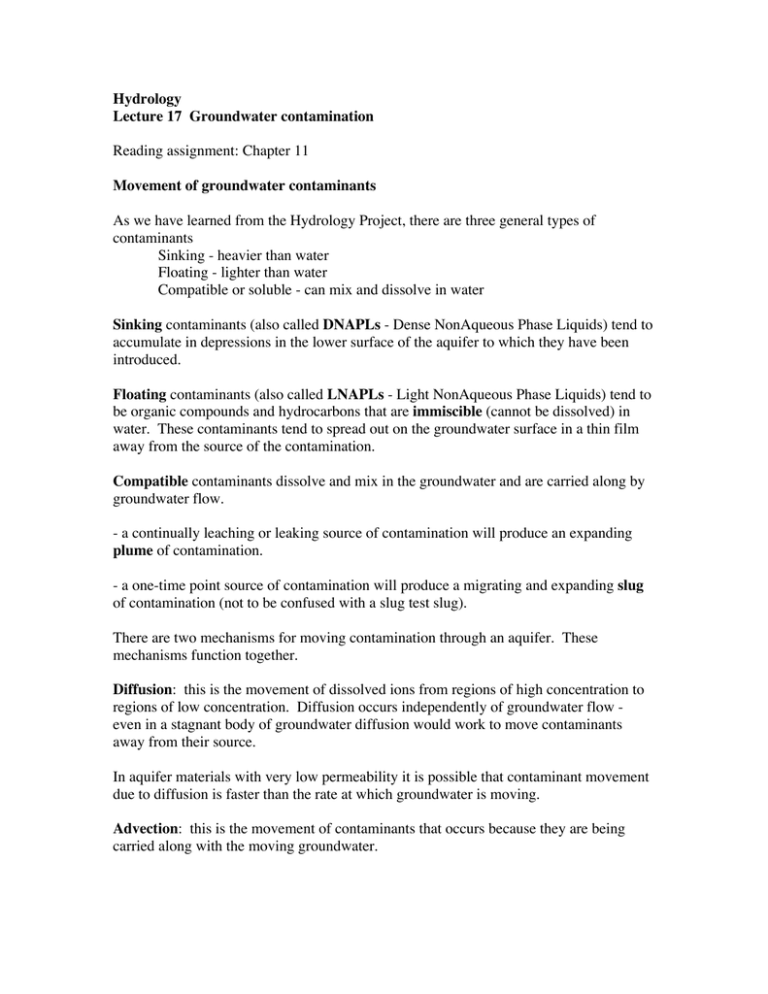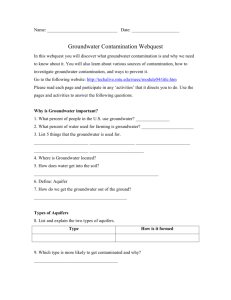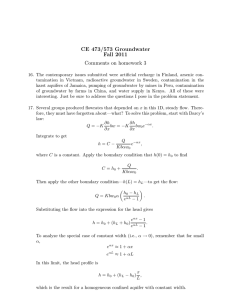Hydrology Lecture 17 Groundwater contamination Movement of groundwater contaminants
advertisement

Hydrology Lecture 17 Groundwater contamination Reading assignment: Chapter 11 Movement of groundwater contaminants As we have learned from the Hydrology Project, there are three general types of contaminants Sinking - heavier than water Floating - lighter than water Compatible or soluble - can mix and dissolve in water Sinking contaminants (also called DNAPLs - Dense NonAqueous Phase Liquids) tend to accumulate in depressions in the lower surface of the aquifer to which they have been introduced. Floating contaminants (also called LNAPLs - Light NonAqueous Phase Liquids) tend to be organic compounds and hydrocarbons that are immiscible (cannot be dissolved) in water. These contaminants tend to spread out on the groundwater surface in a thin film away from the source of the contamination. Compatible contaminants dissolve and mix in the groundwater and are carried along by groundwater flow. - a continually leaching or leaking source of contamination will produce an expanding plume of contamination. - a one-time point source of contamination will produce a migrating and expanding slug of contamination (not to be confused with a slug test slug). There are two mechanisms for moving contamination through an aquifer. These mechanisms function together. Diffusion: this is the movement of dissolved ions from regions of high concentration to regions of low concentration. Diffusion occurs independently of groundwater flow even in a stagnant body of groundwater diffusion would work to move contaminants away from their source. In aquifer materials with very low permeability it is possible that contaminant movement due to diffusion is faster than the rate at which groundwater is moving. Advection: this is the movement of contaminants that occurs because they are being carried along with the moving groundwater. The rate of advection is equal to the rate at which the groundwater is flowing. This is the same as the seepage velocity, and is given by: v = nK e dh dl As contaminants are being advected, they will also be subject to mechanical dispersion. Dispersion is the spreading out of contaminants as they move through the pore spaces of the aquifer. Dispersion occurs because as contaminant ions wind their way through the pores of the aquifer they take different paths. This results in some ions moving faster than others, or moving in directions not directly in line with flow. Longitudinal dispersion: this is dispersion in the direction of flow. It is caused by differences in the rate at which contaminant ions move forward. Ions that find ‘easier’ paths through the aquifer will travel ahead of their slower companions. Lateral dispersion: this is dispersion out to the sides of the general flow path. It occurs as ions meander through different pore paths within the sediment. In flowing groundwater it is impossible to separate the processes of mechanical dispersion and diffusion. The two are lumped together and treated as a single compound effect called hydrodynamic dispersion. The effect of hydrodynamic dispersion is to cause a plume of contamination to elongate in the direction of advection as well as to develop a gradient of decreasing concentration from the center to the margins of the plume. Likewise, a slug of contamination will tend to diffuse radially as it is advected along through an aquifer. Retardation Many cations in a solution of groundwater will have a tendency to become absorbed onto the surfaces of clay minerals. This occurs because the clay mineral surfaces tend to have many naked negative electrical charges that can react with the positive cations. Anions are much less likely to be absorbed owing to the relative scarcity of positive electrical sites on the clay minerals. Also, some ions are too large to be effectively absorbed. Contaminant ions that are easily absorbed onto clay minerals are called reactive. If a contaminant ion is reactive, it will travel slower through an aquifer than a non-reactive contaminant. This results in a retardation of the contaminant front. Each type of contaminant will have a range of absorbtion tendencies depending on the amount of clay in the soil or aquifer material. For a given sample of geological material, the soil-solute specific distribution coefficient (Kd) indicates how strongly a particular inorganic contaminant will be absorbed. Organic contaminants are absorbed onto organic carbon in soils and aquifer sediments. The soil-water partition coefficient (Koc) indicates the tendency for a particular organic compound to be absorbed onto organic carbon. Based on their absorbtion behaviors, organic contaminants are rated by their mobility in groundwater, from very highly mobile to immobile. Immobile contaminants do not travel very far from their plume source as they are aggressively absorbed onto organic carbon and held in place. Pollution plumes often become rather complex as the different contaminant components of the plume are separated into multiple solute fronts dispersing with the flowing soil or groundwater. Contamination sites There are hundreds of thousands of locations in North America and Europe in which contaminants may be a threat to groundwater quality. Fortunately, as of 1981 it was estimated that only 1% to 2% of the aquifers in the United States had contamination problems. In the United States, legislation was enacted in 1980 to identify and clean-up highly contaminated sites. Comprehensive Environmental Response, Compensation and Liability Act (CERCLA) This legislation is better know as ‘Superfund’. Under superfund the EPA has established a National Priorities List of sites targeted for remedial action. New sites, as they are discovered, are added to the list. The objective behind superfund is to find those responsible for the contamination at a site and make them pay to clean it up. The EPA is authorized to clean up a superfind site and then at some time in the future charge those responsible for the cleanup. Unfortunately, it is often difficult to find anybody still in business to charge the costs of a cleanup to. As expenses for highly contaminated sites can run into millions of dollars, superfund is perpetually underfunded. To give superfund some teeth, its reauthorization in 1986 - Superfund Amendments and Reauthorization Act of 1986 (SARA) - greatly extended the limits of liability for paying for the cleanup of a site. Under SARA, all of the following are potentially responsible for paying for cleanup of a site, and any can be billed for the entire cleanup cost, even if they did not actually cause the contamination of the site or only contributed to part of the contamination. Generators of the waste Transporters of the waste Disposers of the waste Operators of the site Current owners of the site, including banks that have foreclosed on the property Previous owners of the site during or after contamination occurred This type of liability is called strict liability and it applies to all parties and previous owners of the site, even if at the time they complied with all existing regulations. Now you know why many large property aquisitions, such as depicted in the Groundwater Project, are preceeded by an environmental audit. Prospective buyers and lenders do not want to be saddled with the liabilities associated with a contaminated site. Major sources of groundwater contamination Septic tanks and Cesspools Septic tanks are small underground containers that transfer household sewage directly into the ground. Sewage drains into the septic tank where it is subjected to anaerobic decay that breaks down the solids. The resulting liquid effluent drains into the surrounding subsurface. Septic tank effluent contains a variety of potential contaminants, including household detergents and chemicals, bacteria, viruses, and nitrogenous compounds. Septic tanks and cesspools are the largest single contributers of wastewater to the ground in the United States. 29% of the U.S. population disposes of its sewage waste in this fashion. On Long Island, much of Nassau County, western Suffolk, and parts of eastern Suffolk County are served by individual septic systems. Septic systems can be an efficient and non-contaminating method of disposing of sewage. This is because as the sewage effluent travels through soil, sediments, and regolith, many of the contaminants are absorbed or filtered. For example, studies have shown that bacteria are filtered by granular geologic materials and die off before travelling very far from the septic source. Viruses are absorbed onto material surfaces and also do not appear to travel far. Also, many household detergents used currently contain Linear Alkyl Sulfonate compounds that breakdown in septic systems. However, if the density of septic systems is very great (as it is over much of Long Island), or if soils are thin or very permeable, or if the water table is close to the surface, then contaminants may not have sufficient opportunity to be filtered from the sewage effluent. Many cases of drinking water contamination occur every year because groundwater supply wells are located to close to septic effluent sources. These include widespread outbreaks of infectious diseases from contamination of public supply wells. It is for this reason that the Upper Glacial Aquifer is no longer pumped over most of Long Island. It has been extensively contaminated by septic effluent. Septic effluent is also sometimes a problem for surface waters, which are particularly vunerable to nitrogenous compounds. Nitrogen rich sewage effluent that discharges into the surface drainage can cause algal eutrophication from the fertilizing effect of the effluent on algae. As masses of algae buildup and die off, the organic material decays and consumes most of the dissolved oxygen in the water, leading to fish kills and other die-offs. Agricultural Activities The main agricultural activities that can cause degredation and contamination of groundwater are the usage of fertilizers (both organic and inorganic), pesticides, and the storage and disposal of animal wastes. Chemical fertilizers are widely used in the intensive agriculture practiced by developed countries. The three main nutrients in chemical fertilizers are N, K, and P. Of these three, only N in the form of nitrate (NO3-) is sufficiently mobile in subsurface flow to be a potential groundwater contaminant. In fact, high NO3- concentrations, often above the levels recommended for drinking water, have been found in extensive areas of many parts of the world, including Isreal, England, Germany, California, Nebraska, Southern Ontario, and Alberta. These are all intensively farmed regions. Pesticide contamination of groundwater has not yet been identified conclusively in major aquifers, but considering the widespread use of pesticides in farming and lawncare, it is considered to be an important potential problem. Landfills In North America approximately 3 kg of refuse per person is produced per day. More than 20,000 landfills across the continent accomodate more than 90% of the solid waste that is produced by industries and municipalities. Currently, solid waste is handled in two ways. It is either buried in sanitary landfills, or it is incinerated and the resulting trash-ash is then placed in a sanitary landfill-like repository. Incineration has two advantages over burial of uncombusted solid waste. Combustion is self-sustaining and electricity is generated that can be sold. Furthermore, the volume of waste that must be stored is greatly reduced (by as much as 90%). Problems with incineration are that volitile contaminants, Hg in particular, and particulate matter can be released into the atmosphere. However, scrubbers and filters can be used to clean the exhaust. Perhaps a more intractable problem is that the incineration process concentrates whatever toxic materials were in the trash to begin with. This is particularly a problem with lead and cadmium. Recently, the Supreme Court ruled that trash-ash generated by municiple incinerators is not exempt from hazardous waste regulations. This is going to make incineration more costly, either because ash will now have to be stored and treated as hazardous waste, or because extra efforts will have to be made to separate out toxic components of the trash (batteries for example). Landfills, both solid waste and ash, are potential sources of groundwater contaminants. Precipitation falling on the landfill tends to infiltrate readily due to the relatively porous nature of trash. Infiltrating water will mix with landfill fluids and leach compounds from the solid waste. The resulting liquid is called leachate. Numerous studies of landfills have shown that the ease with which water can infiltrate in a landfill causes a mound of groundwater to develop within the landfill. This groundwater mounding ensures that water will flow through the landfill and into the aquifer below. Surface waters can be effected by landfill leachate as flow through the landfill often creates leachate springs around the perimeter of the landfill. To prevent leachate plumes, modern landfills are designed to minimize leakage of fluids from within the landfill. Usually, this involves some combination of an impermeable base under the landfill, and leachate collection system, and an impermeable cap on top of the landfill to prevent infiltration of precipitation once the landfill is closed. If the leachate plume does not flow into an aquifer, or if the contaminated aquifer is not used for potable water, then the contamination will not pose a threat to groundwater resources. In fact, cases of useful aquifers being contaminated by landfill leachate are relatively rare. However, it should be noted that large municiple landfills are a relatively recent phenomenon. As current landfills continue to produce leachate for decades or even centuries it remains to be see whether they will become more of a problem in the future. Chemical spills and leaking underground tanks In industrialized countries there are hundreds of thousands of petroleum storage tanks buried underground. Thousands of miles of petroleum pipelines carry hydrocarbons across continents. Buried drums and tanks of waste or discarded industrial chemicals litter abandoned industrial sites. Petroleum products behave differently from many contaminants previously discussed because they are mainly immiscible in water and lighter than water (hydrologists refer to these compounds as light non-aqueous phase liquids -LNAPL’s). Lnaples migrate primarily in the vadose zone. A spill or leakage plume will migrate downward through the vadose zone. On reaching the water table the plume will spread out on the surface of the saturated zone. As an Lnaple plume accumulates on the water table it will spread laterally in response to gravity and capillary processes. Fortunately, Lnaples spills tend to be relatively small and localized, and do not spread very far. As such, they should not present very great groundwater contamination problems. Unfortunately, many Lnaples such as gasoline and heating oil contain a mix of contaminants, some of which are partially soluble in water. This is especially true of very light hydrocarbons. In many cases the solubility of the hydrocarbon contaminants greatly exceeds the acceptable limits for human consumption. Thus, the plume of dissolved hydrocarbons travelling with the groundwater forms a much more serious problem then the localized zone of immiscible hydrocarbon. Dense non-aqueous phase liquids (DNAPL’s) such as chlorinated hydrocarbons can also be immiscible. However, instead of floating on the water table, Dnaples sink through aquifers until they encounter an impermeable zone where they pool and are relatively immobile. As with Lnaples, some portion of the Dnaple may be soluble in water, forming an aquifer plume that travels with the groundwater. Acid mine drainage This should be mentioned because it is a big problem in coal mining regions, particularly in the Appalachian coalfields of Pennsylvania, Virginia, West Virginia, Kentucky, Tennessee, and Alabama. During underground mining and especially strip mining, large quantities of rock are pulverized and discarded in tailings piles. In coalfield strata, much of the rock contains the mineral pyrite. As the pyrite is leached out of the tailings piles by precipitation it oxidizes to produce sulfuric acid. In the Appalachian region, over 6000 tons of sulfuric acid are produced daily by this mechanism. Much of this acid mine drainage ends up polluting local streams. Also, the acidic mine leachate draining through tailings piles can also itself cause the leaching of heavy metals if any are present in the rocks.






